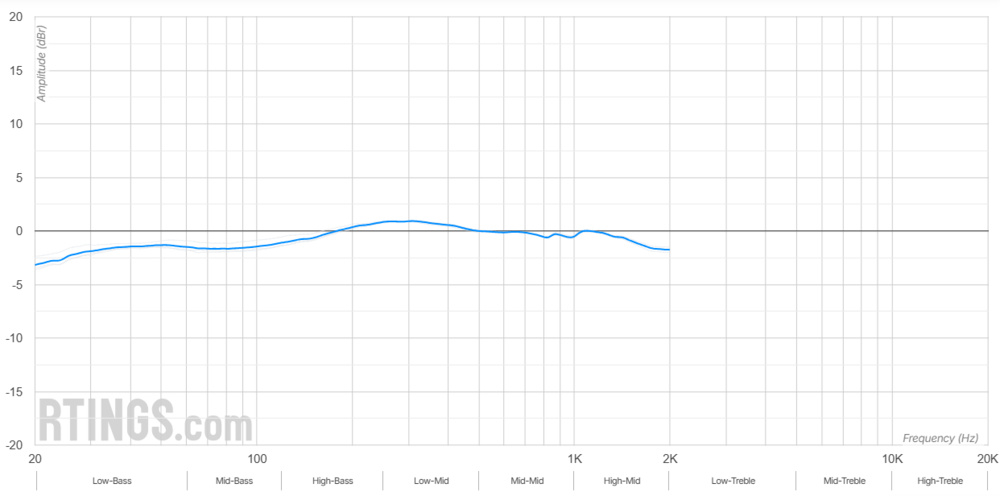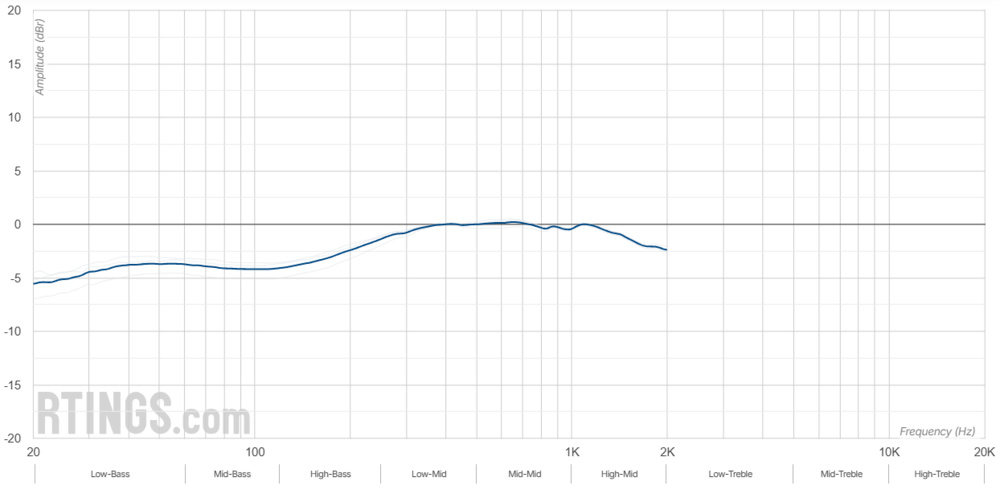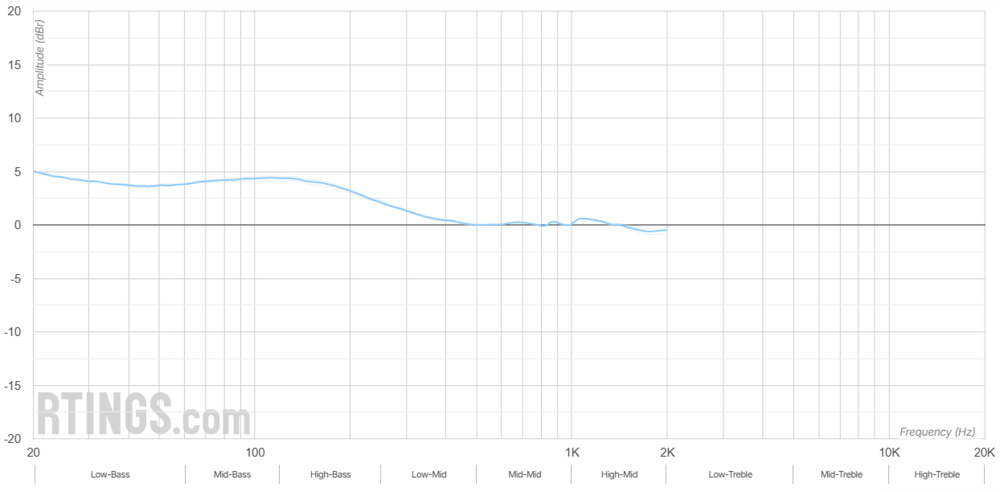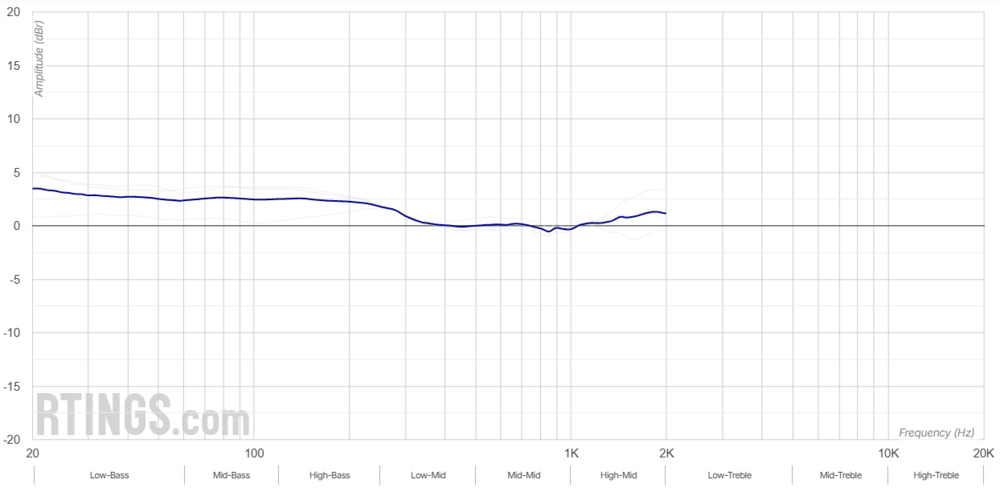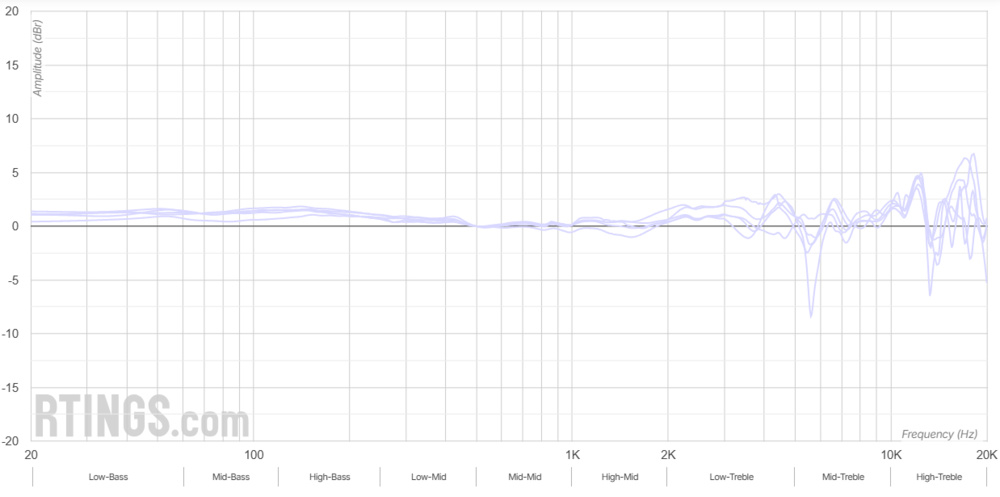- 1.0%Std. Deviation
This article covers our Frequency Response Consistency methodology from Test Bench 2.0 (here's its changelog). Headphones reviews on earlier test benches use different test methodologies, and while the basic concept is similar, this article's methodology is only applicable for TBU 2.0 results.
Frequency Response Consistency is one of the most important headphone measurements we do because it characterizes how headphones sound to different people. This test looks at how headphones perform on people with various traits, so you can find the pair that works best for you. Ideally, headphones should have the same frequency response measurement on everyone for a replicable and predictably similar-sounding experience, but this can vary in practice.
While Raw Frequency Response concerns obtaining a nearly absolute measurement of the sound using the industry standard, Brüel & Kjær 5128 rig exclusively, it doesn't address human measurements or deviations between fittings. Part of the purpose of this test is to help bridge the gap between the rig and the human experience of sound because, for example, if you wear glasses, you may hear a different frequency response due to variables like fit and seal. An inconsistent frequency response shows the limitations of the headphones' ability to sound alike when worn on different people over multiple sessions.
Test results
When It Matters
Frequency Response Consistency is arguably important for everyone when choosing headphones. Each of us has unique physical attributes that can impact how the headphones' audio sounds, whether you're swapping headsets between you and a friend or reseating the same pair on yourself. That said, if you need headphones for sports or listening to podcasts and audiobooks, other priorities like stability and comfort usually take precedence.
The Interaction of headphones with your anatomy
Besides demonstrating how consistently headphones sound to people with different physical traits over the course of multiple listening sessions, this test also helps indicate the quality of the headphones' engineering. With over-ear and on-ear headphones, especially those with closed-backs, a gapless seal around the ear typically ensures a consistent bass output—a frequency region that's sensitive to seal. On the other hand, a poor seal tends to result in an uneven or dramatic drop in the frequency response's bass. To give an example, the materials used for the earpads may physically compress too much, too little, unevenly, or create gaps in the seal. Some headphones, like the Sennheiser HD 490 PRO, include earpads with channeled divots to fit around eyeglasses, which can result in better frequency response consistency for people with glasses.
Additionally, the size and shape of your head influence how loosely or tightly the headphones clamp, and whether you experience gaps in the seal because the headphones' design doesn't accommodate your head shape. Over-ears with large ear cups can leave a lot of room for variation when it comes to the distance and angle of the drivers relative to your ears, which can also alter the sound you hear between wears. Consistency of sound isn't limited to ear cup size either—headband position and sizing impact the sound, with how far forward or backward the headband rests along the top of your head. A poor range of sizing adjustments or large jumps between headband notches, like on the Audeze Maxwell Wireless, means the headphones struggle to accommodate a range of people.
Some headphones perform well with one person but produce an inconsistent frequency response with someone else who has totally different traits. Most of us don't need a consistent frequency response with every single physical attribute unless we intend to share headphones. However, you'll want to see consistent measurements of the subjects with physical attributes that most closely match you, which means you don't need to see a perfect score for personal use but rather a consistent result for yourself.
In-ear headphones and earbuds can yield variance in sound between people, but glasses, hair length, and head size don't factor into their frequency response consistency. The emphasis here is to choose the correct ear tip size and position your earbuds carefully and symmetrically in each of your ears with each listening session.
Our Tests
Standard Deviation
For the Frequency Response Consistency test, the headphones are first calibrated to 94 dB/SPL at 500Hz using the Brüel & Kjær 5128's internal microphones. We take five passes with the B&K 5128's microphones using a 10-second audio sweep played back through the headphones, removing the headphones and re-seating them for each pass.
For measurements on human subjects, the tester fits a pair of binaural in-ear microphones in the B&K 5128's ears and then calibrates these binaural mics to 94 dB/SPL at 500Hz before placing them in the first test subject's ears. Next, the first human subject positions the binaural in-ear microphones in their ears and puts the headphones on over top. The same audio sweep files play back through the headphones (at 84 dB/SPL), and then Audio Precision Analyzer runs the calculations, including compensating for the 10 dB difference between the calibrated mics and human passes. The person removes the headphones and repositions them on their head for another pass. We perform this test three times per person to create two average results, one for each subject's L/R side, in addition to the single test passes.
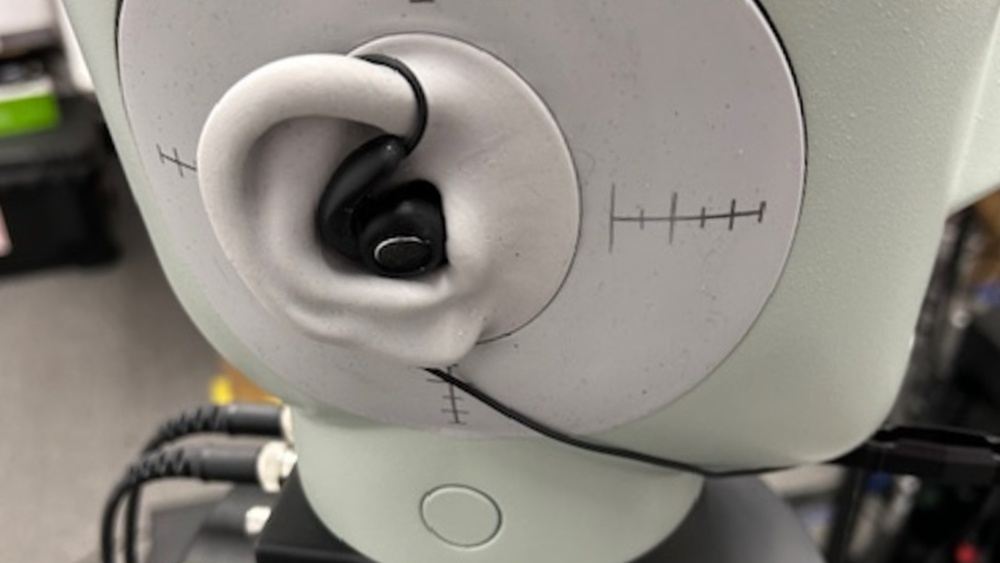 |
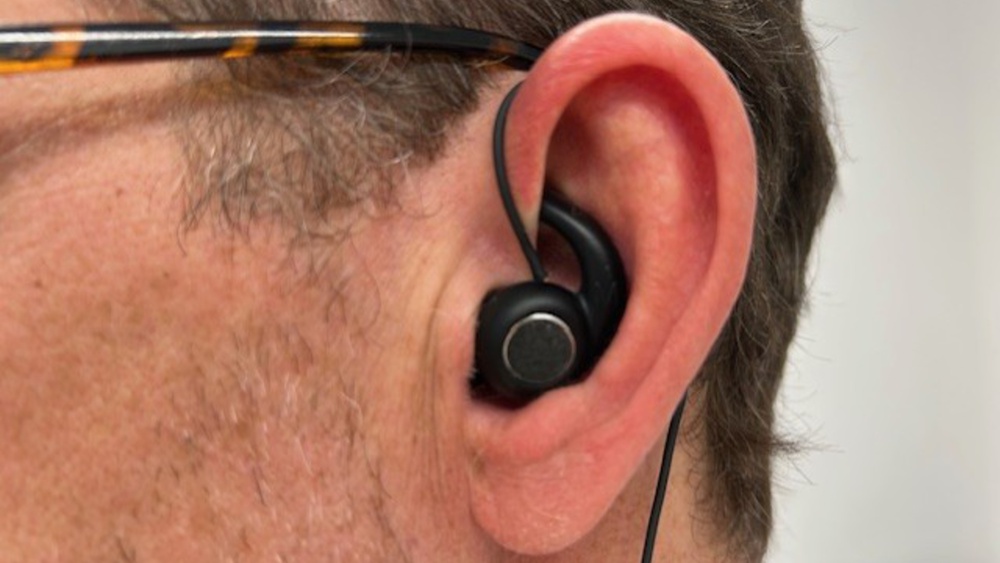 |
We calibrate the MS-TFB-2-MKII Sound Professionals In-Ear Binaural microphones. |
The headphones are placed over the subject's ears wearing the mics. |
This process occurs with five people with small, medium, and large-sized heads, one subject who wears glasses, and one person with long hair. The graphs show the passes for the left and right ears.
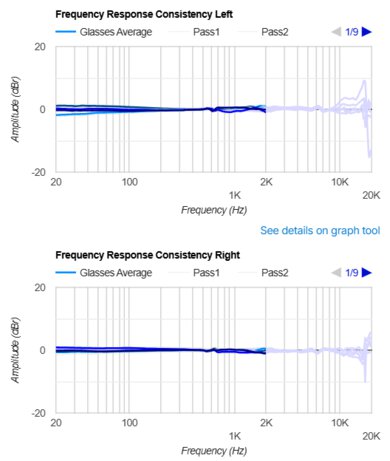
The score is calculated from the standard deviation of a population of mean deviations of proportional human and B&K 5128 measurements across the measured frequencies.
For this test, the frequencies we evaluate range from 20Hz to 2kHz with the human measurements. We don't display the results for human measurements above 2kHz because the head-related transfer function (HRTF) has a greater impact on high frequencies between people. Since the binaural mics necessarily block the ear canals of the people wearing the headphones for the test, this limits the results' usefulness for high frequencies on humans due to the aforementioned HRTF, anyhow. The human passes of the test address the response's consistency in the bass and mid-range by showing the effects of a good seal and pinna interaction with fewer deviations.
The graph traces represent deviations from the frequency response for both human and B&K 5128 measurements, each plotted relative to its own benchmark. Since the graph is normalized, the traces represent variation within each measurement type and aren't meant for direct comparison.
In-ear headphones testing
We measure the Frequency Consistency of IEMs and earbuds a little differently than over-ears and on-ears. Although we use the same 94 dB/SPL audio sweep as with over-ear headphones, this test only uses the B&K's HATS mics for the in-ears test because the binaural in-ear mics prevent the earbuds from fitting people correctly. All three passes (per side) utilize the B&K 5128 test head.
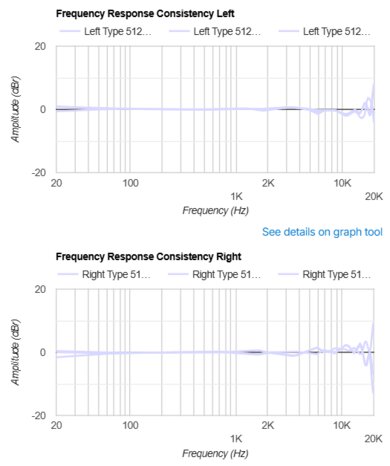
As with over-ear and on-ear headphones, the in-ear headphones test indicates how consistent the sound is between listening sessions. However, the in-ear headphones measurements don't demonstrate the sound's consistency when worn by people with different physical attributes. Unlike the human passes of over-ears, the Frequency Response Consistency test for in-ear headphones includes the full audio spectrum measurement. We include the upper frequencies for these in-ear measurements because they're all taken with the B&K 5128 test head's microphones using the simulated ear canals, but generally, above 10kHz, your anatomy will influence how you hear those frequencies in such a way that variations are expected between people anyway.
Graph Tool
If you click 'See details on graph tool' beneath the Frequency Response Consistency graph in a review, it'll take you to a full page interactive chart, where you can toggle on/off the different measurements. So, if you have a large head, for example, you can filter out the other results (such as the small head tests) that aren't relevant to you. You can even add a second pair of headphones' Frequency Response Consistency results for direct comparison.
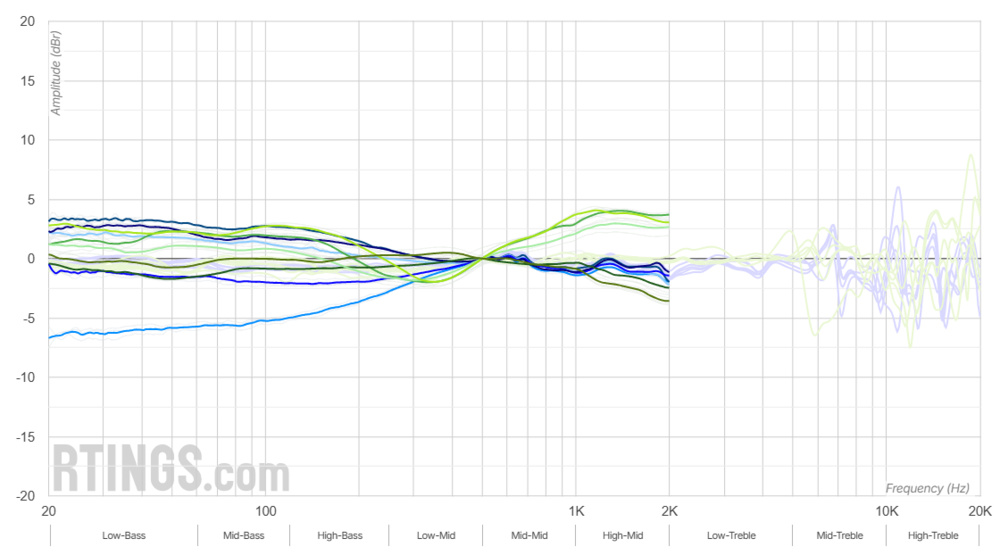 |
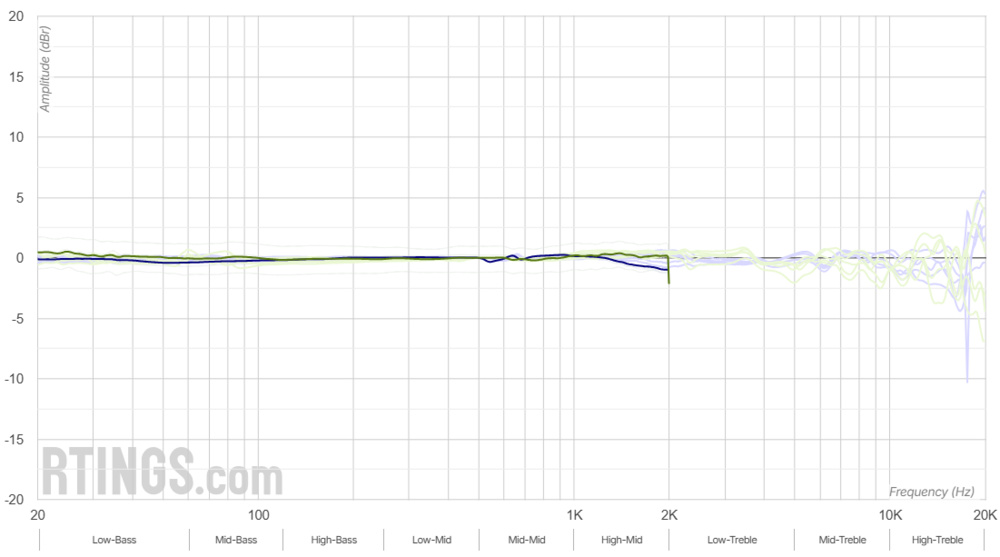 |
You can compare results between headphones. Here's a comparison of all the FIIO FT1 (blues) and AIAIAI TMA-2 DJ (greens) Frequency Response Consistency results. |
Selecting the traits that apply to you makes comparisons more legible, in this case, here are the 'large head' measurements for the Sennheiser HD 490 PRO (blues) and Audio-Technica ATH-ADX3000 (greens). |
The examples below show the averaged passes using the same headphones (the SteelSeries Arctis Nova 7 Wireless) on the different human subjects we measured, and at the bottom of the table, on the B&K 5128. Keep in mind that the B&K 5128 and human measurements don't share the same benchmark and are essentially two graphs overlaid atop one another with a normalized baseline. Since they don't share the same benchmark, you can't directly compare the human measurements with the B&K measurements.
If you're curious how many decibels/SPL make a difference, consider that loudness is perceived on a logarithmic scale rather than linearly. Put simply, the difference between 10 dB/SPL and 20 dB/SPL isn't perceived as twice as loud, but rather, 10 times as loud. As a result, a few decibels difference in the Frequency Response Consistency can still dramatically alter how the headphones sound.
What Isn't Included
As discussed earlier, there are a few inherent limitations with this test, but in short, here's what the test doesn't address:
- Human measurements with in-ear headphones and earbuds
- Human passes for frequencies above 2kHz with over-ear and on-ear headphones
- Every possible combination of hairstyle, hair texture, head size, head shape, and eyewear worn with all of those combinations
- Human measurements with direct comparisons to the B&K 5128 measurements
If you think we've missed an important physical trait for our Frequency Response Consistency measurements, please let us know in the comments or email feedback@rtings.com.
Conclusion
Consider Frequency Response Consistency as a key component for picking headphones that sound predictably similar over repeated listening sessions, and for over-ears and on-ears, with few variations when worn by people with different physical traits. We determine the score in two ways: with human subjects and fitted on our testing rig's head. While a perfect Frequency Response Consistency score is ideal, most people will benefit from consulting results that align with their unique physical characteristics.
Recent Changes
08/11/2025: We've added a video explanation of the test to the Introduction. The test process steps have been rephrased to make it clearer that we use the B&K 5128's built-in microphones for this test.
